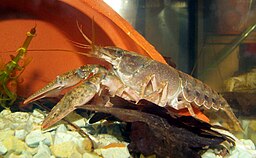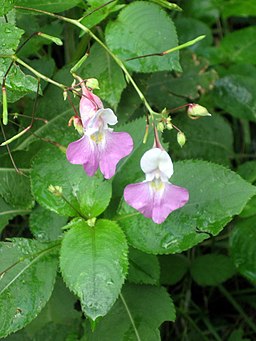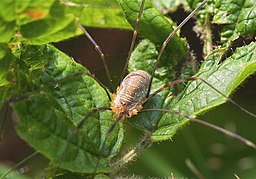 |
Five-leaved Virginia creeper | Status LU: established. 1st record: LU <1872, ITW 1958. |
 |
Fënnefbliedereg Wëll Rief | Status Eur.: established. 1st record: FR 1629.1 |
 |
Vigne-vierge à cinq folioles | RA: ISEIA: B1, Watch List. Harmonia+: 0,34. |
 |
Selbstkletternde Jungfernrebe | Wikipedia: |
 |
Vijfbladige wingerd | Back to the list of neophytes |
Contents
General note on Parthenocissus spp.
 Originally observed in man-made habitats, these popular garden plants can be found increasingly in natural habitats like coastal dunes, riparian habitats and wood margins (Parthenocissus inserta) or rock outcrops (Parthenocissus quinquefolia). They usually thrive on nutrient-rich soils. Seeds are dispersed over long distances by birds. With its dense growth, the plant may cover, out-compete and kill native vegetation (Branquart et al. 2011).
Originally observed in man-made habitats, these popular garden plants can be found increasingly in natural habitats like coastal dunes, riparian habitats and wood margins (Parthenocissus inserta) or rock outcrops (Parthenocissus quinquefolia). They usually thrive on nutrient-rich soils. Seeds are dispersed over long distances by birds. With its dense growth, the plant may cover, out-compete and kill native vegetation (Branquart et al. 2011).
Notes on species distribution and identification
The data situation is poor, which makes it difficult to assess the distribution of Parthenocissus species.
Parthenocissus inserta (A. Kerner) Fritsch has long been confused with Parthenocissus quinquefolia (L.) Planch. originating from North America. However, the latter is distinguished by its more branched twists (5-8 twists per twist, compared to gen. 3-5 in P. inserta), with branches provided at their end with a differentiated adhesive disc (simply swollen at their end in P. inserta) and by its leaflets with more obtuse and generally less deep teeth. A hybrid between the two species is also reported. It remains to be seen whether P. quinquefolia and the above-mentioned hybrid have been found in a subspontaneous state in the wild (Lambinon & Verloove 2012: 457).
The identification characteristics given here often cannot be checked on the collected herbarium material because certain organs are missing.
These characteristics are also questioned by various authors: “Traditionally the two species have been separated on the basis of the branching of their tendrils and the formation of adhesive pads where the tendrils make contact with a solid surface. However, there has been some suggestion that this is not a reliable characteristic and that both species will form adhesive pads, just to varying degrees” (David 2010).
During the research of first records for Parthenocissus spp., we were not able to assess available documents and specimens, due to diverging morphological descriptions in floras and missing organs on specimens, which led us to assess on the genus level only (Ries & Krippel 2021).
We conclude that the genus should be revised in Luxembourg: samples and herbarium specimens should be collected from all known occurrences, in the wild as well as cultivated, and the tendrils should be documented as well with photos, as they are difficult to sample without partial destruction. Together with the old herbarium specimens, they should all be subjected to genetic analysis in order to provide clarity.
Status and distribution in Luxembourg
Records of Parthenocissus quinquefolia (L.) Planch. in Luxembourg. Data source: Recorder-Lux, iNaturalist & GBIF, 2025-12-20.
Parthenocissus quinquefolia (L.) Planch. was first mentioned by Fischer (1872: 22) under its synonym Ampelopsis quinquefolia L. as cultivated ornamental to cover walls. We thus consider the 1st record of the species to be anterior to 1872 (Ries & Krippel 2021).
Parthenocissus quinquefolia (L.) Planch. was first documented by Léopold Reichling (1921-2009) on 1958-06-01 at the Stromberg peak in the municipality of Schengen (MNHNL 2000-).
Currently, 12 records of the five-leaved Virginia creeper are accessible through the MNHNL-mdata portal (MNHNL, iNaturalist & GBIF 2019).
The species, which is frequently planted for wall greening, apparently only very rarely goes wild, which was already observed by Rosbach (1880) in the 19th century (Hand et al. 2016: 599).
Example of escape into the wild
The five-leaved Virginia creeper escaped from Camping du moulin in Bivels into the neighbouring ruderal and alluvial vegetation along the barrage lake of the river Our. The plants overgrow the vegetation on the ground and the shrub layer, and climb to the top of ash and alder trees. Photos: C. Ries, 29 April 2020.
Risk assessment
ISEIA protocol
B1 (3+3+2+2), Watch List, reassessed on 10 July 2018 by C. Ries and M. Pfeiffenschneider. Originally assessed together with Parthenocissus inserta as Parthenocissus spp. C1 (1+1+1+1) (Ries et al. 2013: 18).
Harmonia+ protocol
Overall risk score 0,34 = (Overall Invasion score 0,69 x Overall Impact score 0,50) (Ries et al. 2020).
 Invasion
Invasion0,50

 Impact
Impact0,34

 Risk
RiskWorldwide distribution
Bibliography
- Branquart, E., P. Dupriez, S. Vanderhoeven, W. Van Landuyt, F. Van Rossum & F. Verloove, 2011. Harmonia database: Parthenocissus spp. Harmonia version 1.2, Belgian Forum on Invasive Species. URL: http://ias.biodiversity.be [accessed on 2019-10-14]
- CABI, 2021. Parthenocissus quinquefolia (L.) Planch.. In: Invasive Species Compendium. Wallingford, UK: CAB International. URL: www.cabi.org/isc [accessed 2021-03-05]
- David, J.C., 2010. Untangling the climbers – Parthenocissus quinquefolia & P. inserta. BSBI News 113: 60-61.
- Fischer, E., 1872. Les plantes subspontanées et naturalisées de la flore du grand-duché de Luxembourg. Publications de l’Institut royal grand-ducal de Luxembourg, section des sciences naturelles et mathématiques XII: 1-115. Imprimerie V. Buck, Luxembourg.
- Hand, R., H. Reichert, W. Bujnoch, U. Kottke, & S. Caspari, 2016. Flora der Region Trier. 1. Aufl. 1.636 S. in zwei Bänden. Verlag Michael Weyand, Trier.
- Lambinon J. & F. Verloove, 2012. Nouvelle flore de la Belgique, du grand-duché de Luxembourg, du Nord de la France et des régions voisines. Sixième édition. Avec la collaboration de L. Delvosalle, B. Toussaint, D. Geerinck, I. Hoste, F. Van Rossum, B. Cornier, R. Schumacker, A. Vanderpoorten et H. Vannerom. Jardin botanique national de Belgique, Meise. CXXXIX + 1195 pp. ISBN : 9789072619884.
- MNHNL, 2000-. Parthenocissus quinquefolia (L.) Planch. in Recorder-Lux, database on the natural heritage of the Grand Duchy of Luxembourg. Musée national d’histoire naturelle, Luxembourg. URL: https://mdata.mnhn.lu [Accessed 2019-10-14]
- MNHNL, iNaturalist & GBIF, 2019. Parthenocissus quinquefolia (L.) Planch. in MNHNL-mdata, online portal combining species observation from Recorder-Lux, iNaturalist and GBIF. National Museum of Natural History, Luxembourg. URL: https://mdata.mnhn.lu [Accessed 2019-10-14]
- Ries, C. & Y. Krippel, 2021. First records of 56 invasive alien vascular plants in Luxembourg. Bulletin de la Société des naturalistes luxembourgeois 123: 115-127. [PDF 241 KB]
- Ries, C., Y. Krippel & M. Pfeiffenschneider, 2020. Risk assessment after the Harmonia+ protocol of invasive alien vascular plant species in Luxembourg. Bull. Soc. Nat. luxemb. 122: 197-205. [PDF 132 KB]
- Ries, C., Y. Krippel, M. Pfeiffenschneider & S. Schneider, 2013. Environmental impact assessment and black, watch and alert list classification after the ISEIA Protocol of non-native vascular plant species in Luxembourg. Bull. Soc. Nat. luxemb. 114: 15-21. [PDF 652 KB]
- Rosbach, H., 1880. Flora von Trier. Verzeichniss der im Regierungsbezirke Trier sowie dessen nächster Umgebung wild wachsenden, häufiger angebauten und verwilderten Gefässpflanzen nebst Angabe ihrer Hauptkennzeichen und ihrer Verbreitung. 2 Bände. Ed. Groppe, Trier 1880. 231 und 197 Seiten.
Page content last updated on 2021-09-16.
- Cf. Fischer 1872: 22. 1679 is mentioned for UK at CABI 2021.[↩]




































